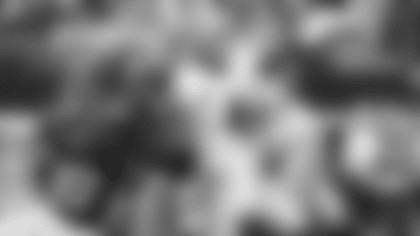Jason Garrett and the Cowboys did an outstanding job of filling positions of need in free agency this offseason, and perhaps no component of the roster needed more work than the interior line. Dallas lost two-thirds of their starting interior line trio from 2011, failing to re-sign Montrae Holland and releasing Kyle Kosier. The 'Boys replaced their veteran guards with Carolina's Mackenzy Bernadeau and Cincinnati's Nate Livings, opting to keep center Phil Costa in the mix.
Obviously, the Cowboys have suffered a setback with Bernadeau, who underwent hip surgery this past weekend and should miss the next 2-3 months. If it's closer to three months, Bernadeau would likely miss the start of training camp out in Oxnard, Calif.
Although there were no guarantees Bernadeau would have won the starting job, but he did figure to be a leading candidate this summer in the OTAs and mini-camp.
But long before the latest injury to Bernadeau, it's pretty obvious the organization placed an emphasis on upgrading the interior line, and for good reason. Although guards and centers don't receive the same kind of attention as offensive tackles, possessing solid interior linemen is extremely valuable to a team. To prove this idea, I charted NFL team wins alongside interior line quality, as per Pro Football Focus.
[![Click here to view this image at full size in another window... internal-link-placeholder-0]](/assets/images/imported/mediacontent//ver1-0/content/images/store/7/13/971fcb11-fc4f-4854-9dca-73fe74dd20ed-large.jpg)
Since 2008, teams that have had a guard or center that ranked in the top 20 among all interior linemen have compiled an average of 9.18 wins per season. On the flipside, those teams that had an interior lineman in the bottom 20 in the NFL averaged just 7.23 wins per year. That's a pretty substantial difference considering a sample size of 2,560 total games. The difference in wins has been apparent in each of the last four years, including a 2009 season when teams with at least one top-tier interior lineman won 3.2 more games than those with bottom-tier guards and centers.
So how will a healthy Bernadeau and Livings aid the Cowboys' offensive line efforts this season? It's really difficult to judge how linemen will fit into new schemes, but both players performed pretty well in 2011.
Panthers running backs averaged 4.34 yards-per-carry when Bernadeau was at the point of attack last year, and Bengals running backs carried the ball for 3.98 YPC behind Livings. Those numbers might not seem sensational, but the upside of interior runs is necessarily limited due to an abundance of short-yardage and goal line attempts. As a comparison, I charted the Cowboys as totaling 4.10 YPC on runs behind Costa, Kosier, Holland & Co. last year. In 2010, the interior run average was just 3.41.
Of course, team rushing success varies based on a variety of factors. It's easier to assess pass protection, however, since offensive linemen generally go one-on-one against a defender. Below, you can see the pressure rates for Bernadeau and Livings over the past three seasons, i.e. the percentage of pass plays when they allowed their defender to force the quarterback out of the pocket. In my view, pressures are better than sacks for grading offensive linemen because they are far less fluky.
[![Click here to view this image at full size in another window... internal-link-placeholder-0]](/assets/images/imported/mediacontent//ver1-0/content/images/store/11/3/fbb573eb-6761-4bec-a393-7405b38c8473-large.jpg)
You can see both Bernadeau and Livings had career years in pass protection in 2011, allowing pressure on 2.08% and 1.64% of snaps, respectively. As a point of comparison, the average pressure rate among all NFL interior linemen since 2009 has been 2.91 percent. The Cowboys have checked in right around that number, allowing interior pressure on 2.7 percent of pass plays over the past three seasons.
Ultimately, the effectiveness of both free agent guard acquisitions will be strongly linked with their health. Bernadeau and Livings have both experienced their fair share of injuries over the years, and playing hurt has undoubtedly adversely affected some of their numbers. With little depth behind the starters, staying healthy will be critical for the interior linemen.
Another key factor in the Cowboys' interior line success will be the starting center, with Costa, Kevin Kowalski and Bill Nagy the likely competitors. Assuming Costa wins the job, as Rob Phillips believes, he'll need to improve his snaps. I actually think Costa is on the right track – he allowed a 2.5% pressure rate in 2011 – with the primary area of potential improvement simply being mental.
Undrafted rookie guard Ronald Leary could also make an impact this year. The Cowboys guaranteed a portion of his salary, meaning the team views him as all but a lock to make the roster. That's high praise for an undrafted free agent, although Leary certainly possesses NFL-caliber talent. He would have been drafted if it wasn't for a knee condition, and there's no ruling out the Cowboys' undrafted free agents.
While the interior line starters might not be set in stone, their importance is not up for debate. With all the talk of third receivers and backup tight ends, the play of the interior line could make or break the Dallas Cowboys in 2012.





